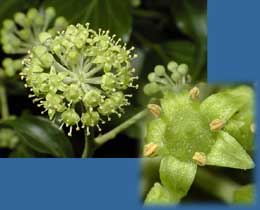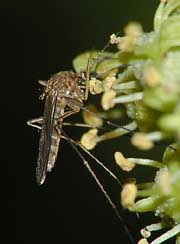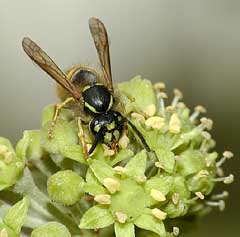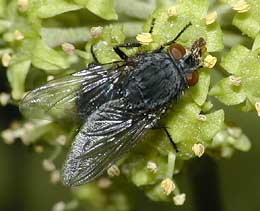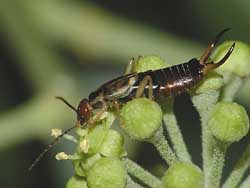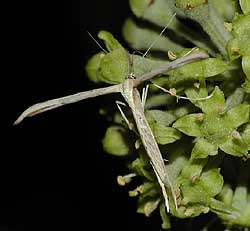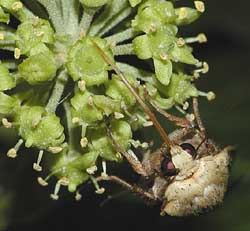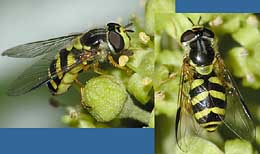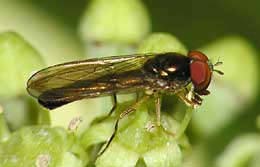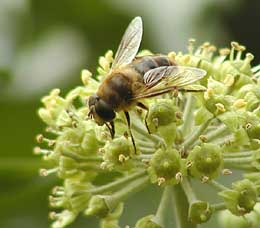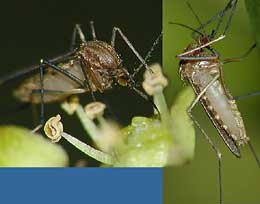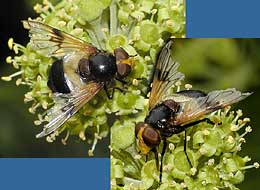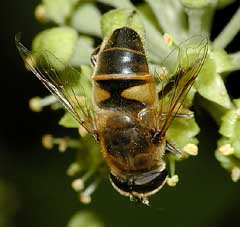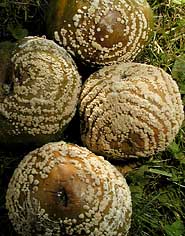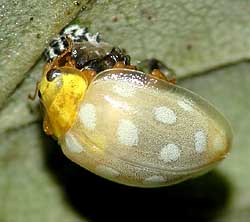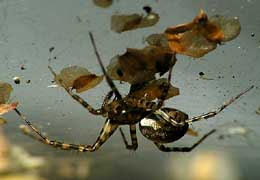Go to last entry........................................Go to previous entry
The Ivy has started flowering now. With luck it will attact some butterflies amongst the assortment of insects that are attracted by its pungent aroma. A large, dark bodied dragonfly spent a bit of time darting about the garden this afternoon, but I could not get close enough to photograph it. We now have regular visits by a robin again now, and a pair of Blue Tits came to the sunflower feeder.
An inspection of the Ivy at 10pm revealed some night-time nectar drinkers in the form of a number of male mosquitoes (Culex pipiens - I think).
I also spotted a couple of bees and a large, dark housefly (?) on the flowers, although I couldn't get close enough to photograph them.
This afternoon I spent some time on a ladder watching insects on the Ivy. Wasps continued to be the main visitors, there were numerous visits by flies like this one, a Bluebottle, I think ( a slightly fuzzy image, I'm afraid).
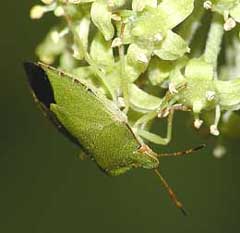
Also, I spotted two of these Common Green Shield Bugs, although I didn't see them feeding.
The first is a Common Earwig (Forficula auricularia). These are seen on flowers just about every time I go out with a torch. They are usually wary of the light, but this one seemed to be too busy feeding to worry about it.
There were several of these Common Plume Moths (Emmelina monodactyla) feeding through a very long and delicate proboscis. To see this you will need to look at the larger verion of the image.
In contrast, the proboscis of this moth is more like a Burger King drinking straw, except that it is a lot more flexible. The moth just hung onto the lower flowers of the inflorescence and let its tongue do the exploring in a large arc. Beyond saying that it was a Noctuid moth, I did not try to identify it as I couldn't get a good view if its wings without disturbing it.
Today my time seems to have been split between being at the top of our Leylandii trees, being on top of a step ladder next to the ivy, or checking the ladybird pupae. As for the pupae, there is nothing to report today. The Leylandii are on their way to becoming about 5ft shorter - job half done today and five nests found so far. I hope the birds will not be put off by the reduced height next Spring. The Ivy flowers are now bursting open all over the plant, and the strong, sweet aroma is unmistakable. The wasps are the main visitors through the morning and early afternoon, although there were only a few about by 5pm. Bluebottles and similar flies are frequent visitors and at lunchtime, when it was sunny, I caught a glimpse of the first Red Admiral at the top of the Ivy tree.
It seems to be steadying a stamen with one of its front legs as it samples the pollen.
This second, smaller hoverfly also seems to be sampling the pollen. A slightly blurred image, but I have included it because of the way it's using both its front legs to hold the stamen.
There were numerous visits by bumble bees, although I didn't manage to get any pictures. Several of these flies appeared while I watched the ivy. The nearest I can see to them in my insect guides is a Narcissus-fly, the larvae of which damage the bulbs of narcissi and similar plants.
Last night was disappointing, with only a couple of Plume moths and several mosquitoes feeding on the flowers. The picture shows one of these, with its abdomen distended as it first gorged on the nectar, and then rested on a leaf.
As well as the small hoverflies there were larger examples, including this heavyweight, which may be Volucella pellucens. Notice how ragged its wings are.
Another large hoverfly that was numerous today was this Drone-fly (Eristalis tenax) that looks so much like a honey bee. A Speckled Wood butterfly spent a short time feeding on the Ivy, but out of reach of my lens.
I spent a couple of hours away from home in the late morning and on my return there was a small circular patch (about 1ft across) of grass covered with a thick carpet of feathers by the side of the small pond. It looks as though the local Sparrowhawk had an early lunch!
24 September - No photographs over the last few days. My days have been taken up with spending time at the top of the Leylandii, continuing with my pruning, and being struck down with a very unpleasant tummy bug! There was a moment of excitement while I was up the trees in that the Sparrowhawk attacked the birds in the Hawthorn. I looked down as the Sparrows fled in panic - most of them heading into the branches immediately below my feet, followed shortly afterwards by the hawk who seemed to carry on through. I have come across a total of ten nests so far. The last few days have seen cooler weather and less activity around the Ivy. The ladybird pupa I have been watching has yet to change.
The first is of a few windfall apples from my neighbour's tree. As they gradually decompose, concentric rings of fungal sporing bodies have been decorating them. There seems to be a disappointing level of insect activity around the Ivy - probably as the weather has continued to be cool. We are still not getting rain and last night I topped up the ponds again.
I have to return to the Orange Ladybirds today. Back on the 11th I photographed a larva antering its pre-pupal stage and then two days later as it transformed into a pupa. Well, this morning that pupa has undergone its final transformation into the adult. Frustratingly, I missed the moment again, but the picture was taken as it was still extracting its legs from the pupal skin.
While our Birch tree has not yet started shedding seeds yet, the one in my neighbour's garden has already started, and this spider is finding its cobweb gradually collecting the winged seeds.
I managed to get the rest of the leylandii tops trimmed today. Now I need to deal with the sides! |
|
